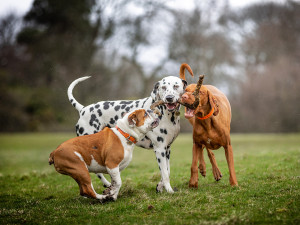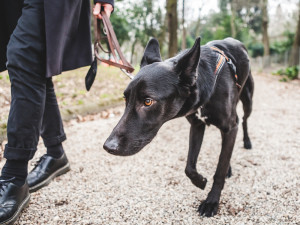Dogs Have an Impressive Ability to Cope with Novelty
Unlike many other animals, dogs can handle new things in stride.

Share Article
Dakota had previously struggled with behavioral issues, but this time, he really went bananas. When the cell phone began to vibrate on the table, he panicked, which is why he jumped through the window, shattering it and scaring a couple of kids riding by on their bikes. Luckily, his person was able to calm him down, and his injuries were minor. Is he a bad dog? No.
The situation was just more than he could handle. It would be unfair to call his response “bad,” though it was certainly undesirable. Oh, and Dakota isn’t a dog, technically speaking. He’s a wolf hybrid, and like most animals, reacts strongly to anything new — a sound, a person, an object, or a situation. Their difficulty with novelty is one of the main reasons I don’t recommend people get wolf hybrids as pets. But dogs are different.
Super Adaptability
Dogs tend to respond more easily to new things, which is why they make great pets. Their ability to take “new” in stride is part of what makes dogs who they are. Perhaps best of all, they quickly form new social bonds throughout their lives, which is why many people are able to have loving, close relationships with rescue dogs.
Most dogs are able — even expected — to face new situations without blinking (and, for that matter, without barking). Think of what is typically asked of dogs. Many are placed with new people in a new home at the age of seven to 10 weeks. Some stay in that home, but others are rehomed, in some cases, multiple times. Even dogs who stay with the same family will face much that is new.
They might be taken out in a canoe or spend the night in a kennel while the floors are being refinished; eat a different kind of food; endure a loud party; welcome a new dog or a new baby or a cat to their household; move to a new home, a new town, from the city to a rural area, or vice versa. They may have to stay with a dog sitter, greet a new dog walker, accept regular rearranging of the furniture, or change routine when their pet parents start working in an office instead of from home. Even if the household remains steady, dogs generally meet new dogs and new people and go to many new places throughout their lives.
One-of-a-Kind
Of course, things don’t always go smoothly. Many dogs struggle to deal with “newness” of one sort or another. Some dogs freak out when they walk on snow for the first time or when the baby cries in the middle of the night. Though dogs tend to handle novelty better than most other species — each dog is still an individual.

Personality and experience both contribute to how a dog reacts to stress, solves problems, and how stressful they find something new. Some dogs may bark, cower or hide; others will growl or lunge; a few will bite. Some pups seek comfort from their pet parents; they might whine, freeze up or approach tentatively; head for their crate; or retrieve a comforting toy.
Similarly, responses to a positive novelty can run the gamut from leaping and spinning, sniffing, grabbing, jumping, whining, barking, or a tail wagging that’s vigorous enough to cause a mini tornado of fur. Behavior has a genetic component; dogs are genetically predisposed to be flexible and adaptable. Yet, genetics do more than account for differences among species. They also explain various behavioral differences among breeds and individuals, including disparities in a dog’s ability to cope with changes in their environment. As in other aspects of canine behavior, this ability also varies. That’s why certain traits such as gregariousness, shyness, curiosity, and fearfulness can actually run in lines of dogs.
Helping Dogs Adapt
So, some dogs come into this world with greater potential for enjoying newness or at least successfully coping with it. Still, full development of this potential requires the right kind of experiences at the right age.
Exposure
In order for dogs to maximize their ability to respond well to the unfamiliar, frequent and positive exposure to a variety of people, places and situations early on is essential. Without those opportunities, they may not be able to manage the unexpected as adults.
Puppies who encounter grass, cats, concrete, elevators, paper airplanes, toys, kids, blankets, music, oven timers, men and women, stairs, other dogs, people with canes, rugs, bells, hair dryers, fish tanks, mirrors, and a wide variety of other elements of their world are far more likely to develop into adult dogs able to handle them, as well as other novel things, later in life.
Socialization
Exposure to potential social partners has received particular emphasis from behaviorists and trainers. Socialization is the process of becoming aware of the social world and learning how to behave within it. For dogs, it involves making sure that puppies have positive experiences with other dogs and people at the age during which they are most receptive to being influenced by those exposures.
Opportunity
Even brief encounters in the first few months of dogs’ lives can have a large impact on their future behavior. Absent these opportunities, no amount of contact later in life can make up for the deficiency. Dogs whose worlds were limited during puppyhood are rarely as comfortable around new things, including potential social partners, as those whose early months were rich in experiences.
Recovering from Trauma
Because of these missing opportunities, dogs raised in severely impoverished environments — tied up outside or used as breeding dogs in a puppy mill, or in a hoarding situation, for example — struggle to adjust to what most would consider a “normal” environment once they are liberated. In many cases, the problems they face are less a result of the bad things that happened to them and more about the good things that did not. For these dogs, anything new poses a serious challenge, and it can take them months, if not years, to improve. And in the end, it is unlikely that they will ever be able to deal with novelty as easily as dogs with more generous upbringings.
Even well-adjusted, flexible, happy dogs can be shaken by traumatic incidents. These events will affect some dogs more than others, but no dog is immune to the effects of something extremely scary or upsetting.
A study of pet dogs who survived the 2011 Japanese earthquake and tsunami and the nuclear disaster that followed them showed that these dogs had issues and behavior consistent with post-traumatic stress disorder (PTSD). Compared with a control group of dogs who were not involved in the disaster, these traumatized dogs had a harder time learning new skills in training sessions and greater difficulty connecting with new people (caregivers in their rehabilitation program).
Dogs can also be negatively affected by less harrowing but still aversive experiences. They may struggle when meeting new dogs who resemble one who attacked them when they were young, develop a reluctance to go to the park after being caught in a thunderstorm there, or become uncharacteristically terrified of strangers as a result of being home alone during a burglary.
On the other hand, many dogs do more than just accept new things in their lives; they sometimes actually prefer them. In one study, dogs were offered three toys — two familiar and one novel — and chose the new toy first in nearly 80 percent of the trials, indicating a preference for the new item over the well-known.
The range of situations, objects, and social partners that most dogs take in stride is enormous. It’s something people tend to take for granted. A dog’s ability to roll with whatever situation they find themselves in is really amazing and far from typical in the animal world.

Karen B. London, PhD, CAAB, CPDT-KA
Karen B. London is a certified applied animal behaviorist (CAAB) and certified professional dog trainer (CPDT) who specializes in working with dogs with serious behavioral issues, including aggression. She has written for a variety of magazines including The Bark, Clean Run, and the APDT Chronicle of the Dog, and has published in scientific journals including Behavioral Ecology and Sociobiology, Ethology, Ecology, and Evolution, the Journal of Insect Behavior, and Insectes Sociaux. She is the author of seven books about dog training and canine behavior, including the forthcoming My Dog's Mystery Adventure: And Other Stories From a Canine Behaviorist and Dog Trainer.
Related articles
![A woman staring at her computer while holding her dog close.]()
10 Things to Consider Before Adopting a Pet
It’s a big decision, so check these boxes before you sign on the dotted line.
![Two Australian Shepherd dogs meeting in the snow]()
Are Your Dogs Arguing With Each Other?
How to tell the difference between dog aggression and communication.
![Woman sitting in a cafe with her dog.]()
Can Your Shy New Rescue Dog Become a Social Creature?
With patience and positive reinforcement, you can do a lot to make up for lost time with socialization.
![Shy black dog walking with owner at the park.]()
How to Help an Anxious Dog Conquer Their Fears
Pro tips for boosting the confidence of a scaredy-cat dog.
![Three dogs on leashes meeting and sniffing each other on a walk on the summer grass with owners]()
How Do I Get My Shy Dog To Socialize?
Kinship Collective dog trainer Robert Haussmann’s tips for getting a shy pup to go from wallflower to social butterfly.






